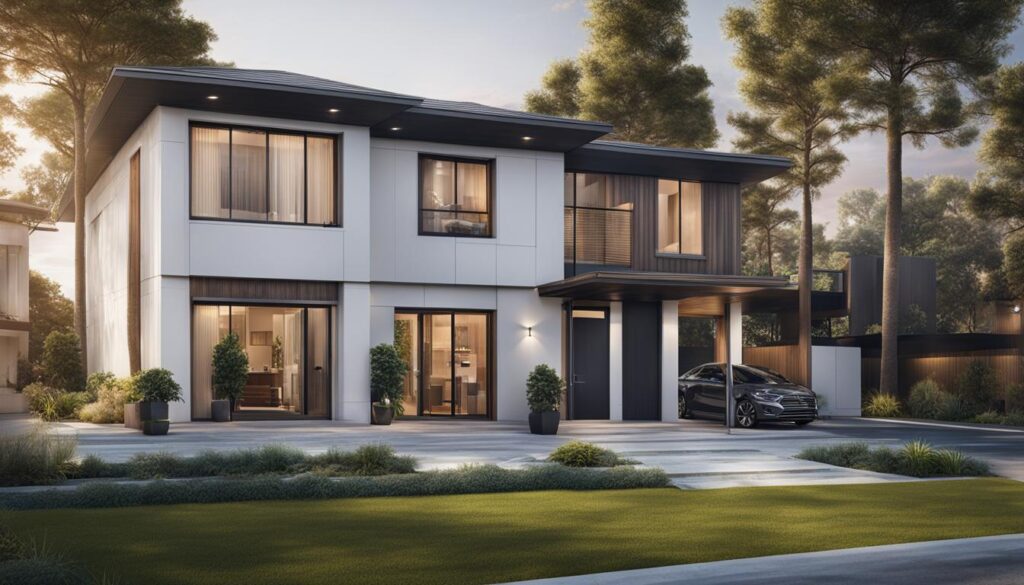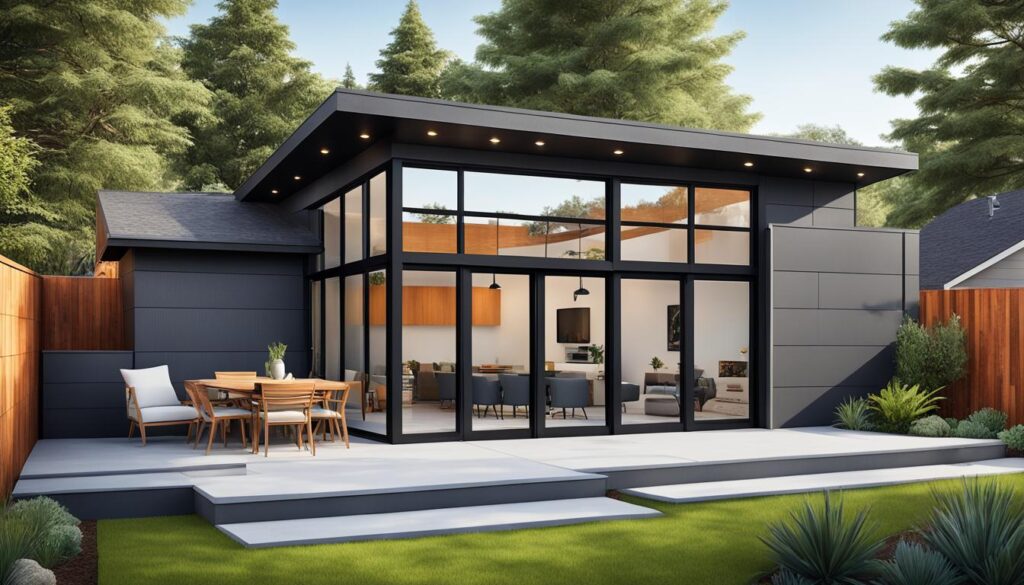Understanding ADUs in Real Estate Explained
ADUs, or accessory dwelling units, are secondary houses or apartments located on the same lot as a primary residence. They are not sold separately and are often used for additional rental income or to accommodate family members. ADUs can be attached to or detached from the primary residence and come in various types, such as in-law units, secondary dwelling units, granny flats, or carriage houses.
When it comes to ADUs, it is essential to understand the specific regulations and requirements that vary depending on the location. Zoning rules dictate the size, style, and even whether the owner must live on the property. Financing options for ADU construction include renovation loans, refinancing existing mortgages, or using available cash. Design ideas for ADUs focus on creating functional layouts, maximizing natural light, and incorporating sustainable features. The construction process involves obtaining permits, hiring contractors, and coordinating with utility providers for connections.
Key Takeaways:
- ADUs are secondary houses or apartments located on the same lot as a primary residence.
- They provide additional income through rental revenue and can accommodate family members.
- ADUs come in various types, including in-law units and granny flats.
- Regulations for ADUs vary depending on the location and are subject to zoning rules.
- Financing options for ADU construction include renovation loans and refinancing existing mortgages.
What Is an Accessory Dwelling Unit (ADU)?
An accessory dwelling unit (ADU) is a secondary residential building that occupies the same lot as a primary residence. ADUs are also known as guest houses, granny flats, or in-law units. These units can take various forms, such as detached standalone structures, converted garages, or additional stories on top of existing buildings. ADUs have their own kitchen, living area, and separate entrance, providing a separate living space for occupants.
ADUs can be attached to the main house or built as separate units on the same property. They are designed to be self-sufficient and often utilize the water and energy connections of the primary residence. This allows residents of the ADU to have their own amenities while still benefiting from the utilities of the main house.
ADUs offer a flexible housing option, allowing homeowners to accommodate extended family members, generate rental income, or provide additional space for guests. They have become increasingly popular in real estate as they offer a solution for addressing housing shortages and increasing property value.
ADUs offer a flexible housing option, allowing homeowners to accommodate extended family members, generate rental income, or provide additional space for guests.
| Type of ADU | Description |
|---|---|
| Detached ADU | A standalone structure separate from the primary residence. |
| Converted Garage ADU | A garage that has been converted into a livable space. |
| Attached ADU | An ADU that is connected to the main house, utilizing a shared wall or space. |
| Additional Story ADU | An extra floor added to the main house to create a separate living space. |
Benefits of ADUs in Real Estate
ADUs offer several benefits in real estate. Let’s explore some of the key advantages:
1. Additional Income:
One of the significant benefits of ADUs is the potential to generate additional income through rental revenue. Homeowners can rent out the ADU to tenants, providing a steady stream of cash flow. This extra income can help offset mortgage payments or serve as a source of passive income.
2. Increased Property Value:
Adding an ADU to a property can add value to the overall real estate investment. The presence of an ADU can make the property more attractive to potential buyers, especially those seeking rental income or multi-generational living arrangements. A well-designed, functional ADU can significantly enhance the market value of the property.
3. Extra Space:
ADUs provide extra space that can serve a variety of purposes. Homeowners can use the ADU as a workshop, home office, art studio, or even a guest suite for visitors. Having an additional living unit on the property increases the flexibility of space utilization, making it easier to adapt to changing needs and lifestyle requirements.
4. Housing Option for Family Members:
ADUs offer a viable housing option for family members, such as aging parents or adult children. The separate unit allows them to have their own living space while still being close to the main residence. This arrangement provides privacy and independence while maintaining the benefits of intergenerational living and support.
Overall, ADUs bring numerous benefits to the real estate landscape. From financial advantages to flexible living arrangements, these versatile units can enhance property value and cater to various needs.
Types of ADUs in Real Estate
When it comes to adding an Accessory Dwelling Unit (ADU) to your property, there are several types to consider. Each type offers its own unique benefits and design possibilities. Let’s explore the different types of ADUs in real estate:
-
Detached ADUs
Detached ADUs are stand-alone structures that are separate from the main house. They are typically located on the same lot and provide complete privacy and independence. Detached ADUs can be designed as independent cottages, tiny houses, or small apartments. They offer flexibility in terms of design and can be customized to fit the specific needs and preferences of the homeowner.
-
Garage Conversions
A garage conversion involves transforming an existing garage into a livable space. This type of ADU is an excellent option for homeowners who have unused garage space. By converting the garage, you can create a self-contained unit with a separate entrance, kitchen, and bathroom. Garage conversions are a cost-effective way to add an ADU to your property while utilizing existing space.
-
Attached ADUs
Attached ADUs are connected to the main house and share common walls. They can be built as separate units or as an extension of the primary residence. Attached ADUs are convenient for homeowners who want to have their family members close by or want to generate rental income without fully separating from the main house. These ADUs often have their own entrances, kitchens, and living areas.
-
Interior Conversions
Interior conversions involve transforming a part of the existing home into a separate living space. This can be done by converting a basement, attic, or unused rooms into an ADU. Interior conversions are a great option for homeowners who want to maximize their current space without making external changes to their property. They are cost-effective and allow for greater convenience and accessibility between the main house and the ADU.
Each type of ADU has its own advantages and can be tailored to suit various preferences and property layouts. The choice of ADU type depends on factors such as available space, budget, and specific needs. Ultimately, ADUs offer homeowners the opportunity to maximize the potential of their property and create additional living spaces that can be used for various purposes.
Regulations for ADUs in Real Estate
When considering the construction of an Accessory Dwelling Unit (ADU) in real estate, it is crucial to understand the regulations associated with these secondary residential units. ADU regulations can vary depending on the location and are typically governed by zoning laws and local housing and community development administrations.
Zoning Laws:
The first and most crucial set of regulations for ADUs are the zoning laws. These laws dictate various aspects of ADU construction, including the size and style of the unit, as well as whether the owner must live on the property. Zoning laws ensure that ADUs comply with the overall character and density of the neighborhood.
Local Housing and Community Development Administrations:
Local housing and community development administrations play a significant role in regulating ADUs. They enforce specific requirements and provide guidelines on ADU construction, permits, and compliance with building codes. It is essential to consult with these administrations to understand the regulations, requirements, and any additional permits needed for constructing an ADU.
“ADU regulations vary by location, so it’s crucial to research and comply with the specific requirements set by the zoning laws and local housing and community development administrations in your area.”
Potential ADU Regulations:
Here are some common regulations that might be applicable to ADU construction:
- Minimum lot size requirements
- Maximum square footage limitations
- Setback requirements
- Parking space requirements
- Design and architectural guidelines
- Utility connections and requirements
- Rental duration and occupancy restrictions
By understanding and adhering to these ADU regulations, property owners can ensure compliance, avoid legal issues, and seamlessly integrate ADUs into their real estate properties.
To gain a comprehensive understanding of the ADU regulations specific to your location, it is essential to consult local authorities, seek legal advice, or engage with experienced professionals in the field of real estate and construction.

Financing Options for ADU Construction
When embarking on an ADU construction project, one of the key considerations is financing. Fortunately, there are various options available to homeowners looking to fund their ADU project. Here are some popular financing options for ADU construction:
- Renovation Loans: Homeowners can explore the option of taking out renovation loans specifically designed for home improvement projects. These loans provide the necessary funds to construct an ADU, allowing homeowners to spread out the cost over a longer term.
- Refinancing: For homeowners who have built equity in their primary residence, refinancing their existing mortgage can be a viable financing option. By refinancing, homeowners can cash out a portion of their home’s equity to be used for constructing an ADU.
- Cash on Hand: Some homeowners may have the financial capability to fund their ADU construction project using cash that they have readily available. Using cash on hand eliminates the need for loans or additional financing, simplifying the process.
- Prefabricated ADUs: Prefabricated ADUs are becoming increasingly popular due to their time and cost-saving benefits. Manufacturers of prefabricated ADUs often offer financing options to facilitate the construction process. It is recommended to explore these options and compare them to traditional financing options to determine the most suitable choice.
It is important to note that while these financing options provide flexibility, they often come with higher interest rates compared to traditional mortgages. It is advisable to carefully consider the terms and conditions of each financing option and assess their long-term financial implications.
“Financing an ADU construction project requires careful consideration of available options and their associated costs. Homeowners should seek professional advice and thoroughly assess their financial situation to choose the most suitable financing option.”
To further illustrate the financing options for ADU construction, take a look at the following table:
| Financing Option | Description |
|---|---|
| Renovation Loans | Loans specifically designed for home improvement projects, including ADU construction. Allows homeowners to spread out the cost over a longer term. |
| Refinancing | Homeowners can refinance their existing mortgage to cash out a portion of their home’s equity to fund their ADU construction project. |
| Cash on Hand | Homeowners with readily available cash can use their own funds to finance the construction of their ADU, eliminating the need for loans. |
| Prefabricated ADUs | Manufacturers of prefabricated ADUs may offer financing options to assist homeowners in the construction process. |
By exploring these options and considering individual financial circumstances, homeowners can make informed decisions when it comes to financing their ADU construction project.
Design Ideas for ADUs in Real Estate
When it comes to designing an ADU, the possibilities are endless. Homeowners have the flexibility to customize both the interior and exterior of the unit to suit their preferences and needs. Whether you’re looking to create a cozy living space for a family member or generate rental income, here are some design ideas to consider:
1. Functional and Efficient Layout
An ADU should maximize space utilization and provide a functional layout. Consider open floor plans and clever storage solutions to create a sense of spaciousness. Designing multi-purpose rooms can also enhance flexibility and optimize the available square footage.
2. Maximize Natural Light
Integrating ample natural light into the design of the ADU can make the space feel larger and more inviting. Incorporate large windows, skylights, or even glass doors to allow sunlight to flood the interior. Natural light can significantly enhance the overall aesthetics and livability of the unit.
3. Space-Saving Techniques
ADUs often have limited square footage, so it’s crucial to make the most of the available space. Consider utilizing built-in furniture, such as Murphy beds or foldable tables, to maximize functionality while minimizing clutter. Opt for space-saving appliances and fixtures to ensure every inch counts.
4. Incorporate Sustainable Features
Incorporating sustainable design elements into the ADU can not only reduce environmental impact but also attract eco-conscious tenants. Consider energy-efficient appliances, LED lighting, low-flow fixtures, and insulation options to achieve optimal energy performance. This not only benefits the environment but can also result in long-term cost savings.
Remember, the design of your ADU should align with your personal taste, lifestyle, and intended use. Don’t shy away from experimenting with different styles, materials, and color schemes to create a unique space that reflects your vision.

With careful attention to design details, your ADU can become a functional and aesthetically pleasing addition to your property, whether it’s for personal use or as an investment opportunity.
Construction Process for ADUs in Real Estate
Constructing an Accessory Dwelling Unit (ADU) involves several key steps that ensure a successful and compliant project. From obtaining permits to coordinating utility connections, each phase contributes to a smooth construction process.
Step 1: Obtaining Permits and Approvals
Before beginning any construction work, it is essential to obtain the necessary permits and approvals from local authorities. These permits ensure compliance with building codes and zoning regulations specific to ADU construction. Depending on your location, you may need to submit architectural plans, engineering documents, and other supporting documentation to get approval for your ADU project.
Step 2: Hiring Contractors or Builders
Once you have the necessary permits, it’s time to hire experienced contractors or builders for your ADU construction. Look for professionals with expertise in ADU construction, as they will understand the unique challenges and requirements of building separate living units. Request references and review their portfolio to ensure they have a track record of delivering high-quality work.
Step 3: Coordinating Utility Connections
During the construction process, it’s crucial to coordinate with utility providers to connect essential services such as electricity, plumbing, and other utilities. Ensure that the design and layout of your ADU account for these connections and meet the requirements set by utility providers. Coordinating with the utility companies in advance will help avoid any delays or complications during the construction phase.
“Coordinating with utility providers early in the construction process ensures seamless connections and avoids delays.”
Step 4: Adhering to Building Codes and Regulations
Throughout the ADU construction process, it’s crucial to adhere to building codes and regulations. These codes ensure the safety, structural integrity, and livability of the ADU. Hiring professionals who are familiar with local building codes can help ensure compliance and avoid potential issues during inspections or future property transactions.
By following these steps, you can navigate the ADU construction process successfully and create a functional and valuable addition to your real estate property.
| Construction Process Steps | Details |
|---|---|
| Step 1: Obtaining Permits and Approvals | Submit necessary documents to obtain permits and approvals from local authorities. |
| Step 2: Hiring Contractors or Builders | Engage experienced professionals with expertise in ADU construction. |
| Step 3: Coordinating Utility Connections | Coordinate with utility providers to connect electricity, plumbing, and other essential services. |
| Step 4: Adhering to Building Codes and Regulations | Ensure compliance with local building codes throughout the construction process. |
Conclusion
In conclusion, ADUs are a popular and beneficial addition to real estate properties. These secondary residential units offer various advantages, including the potential for additional income and increased property value. ADUs also provide flexible housing options, whether for accommodating a family member, generating rental revenue, or creating space for personal use.
However, before embarking on an ADU project, it is crucial to consider the specific regulations and financing options available in your area. Zoning laws and building codes may differ depending on location, so it is essential to familiarize yourself with the requirements and restrictions to ensure compliance.
With careful planning and execution, ADUs can be a valuable asset in the world of real estate. Whether you are seeking financial gain, additional living space, or an opportunity to enhance the functionality of your property, ADUs offer a versatile solution. Take advantage of the benefits ADUs provide by understanding the regulations, exploring financing options, and designing a space that meets your needs and preferences.
FAQ
What is an ADU in real estate?
An accessory dwelling unit (ADU) is a secondary house or apartment located on the same lot as a primary residence.
What are the benefits of ADUs in real estate?
ADUs can provide additional income through rental revenue, add value to the property, and offer extra space or housing options for family members.
What are the types of ADUs in real estate?
The types of ADUs include detached ADUs, garage conversions, attached ADUs, and interior conversions.
What are the regulations for ADUs in real estate?
The regulations for ADUs vary depending on the location and are subject to zoning rules and regulations specific to each area.
What are the financing options for ADU construction?
Financing options for ADU construction include renovation loans, refinancing existing mortgages, using available cash, and potential financing from prefabricated ADU manufacturers.
What are some design ideas for ADUs in real estate?
Design ideas for ADUs include functional and efficient layouts, maximizing natural light, space-saving techniques, and incorporating sustainable features.
What is the construction process for ADUs in real estate?
The construction process for ADUs involves obtaining permits and approvals, hiring contractors or builders, and coordinating with utility providers for connections.
What is an ADU’s definition in real estate?
An accessory dwelling unit (ADU) is a secondary residential building that occupies the same lot as a primary residence.
















It's great that you talked about how business insurance can provide financial protection against unexpected events and help ensure the…
I like that you mentioned how business insurance is essential for protecting your bottom line and the long-term viability of…